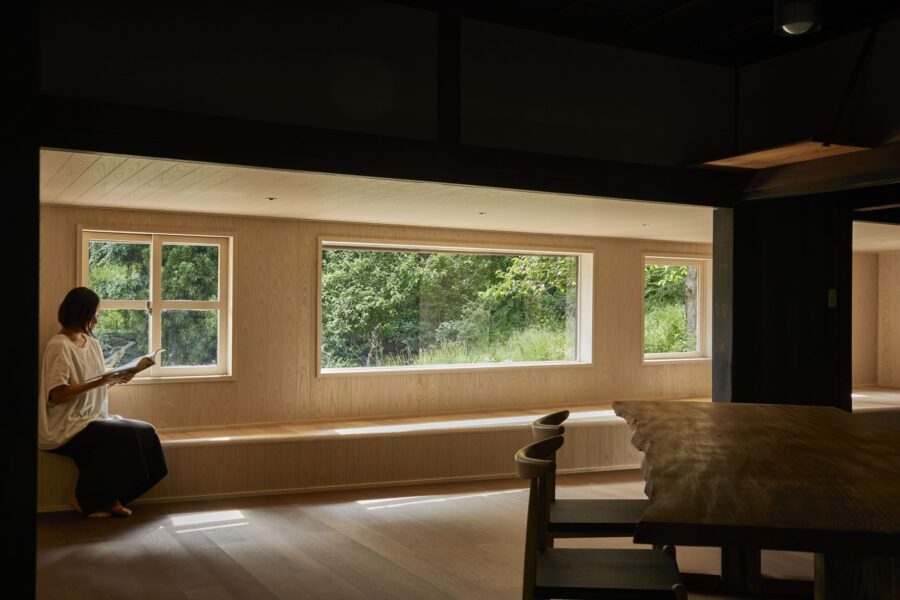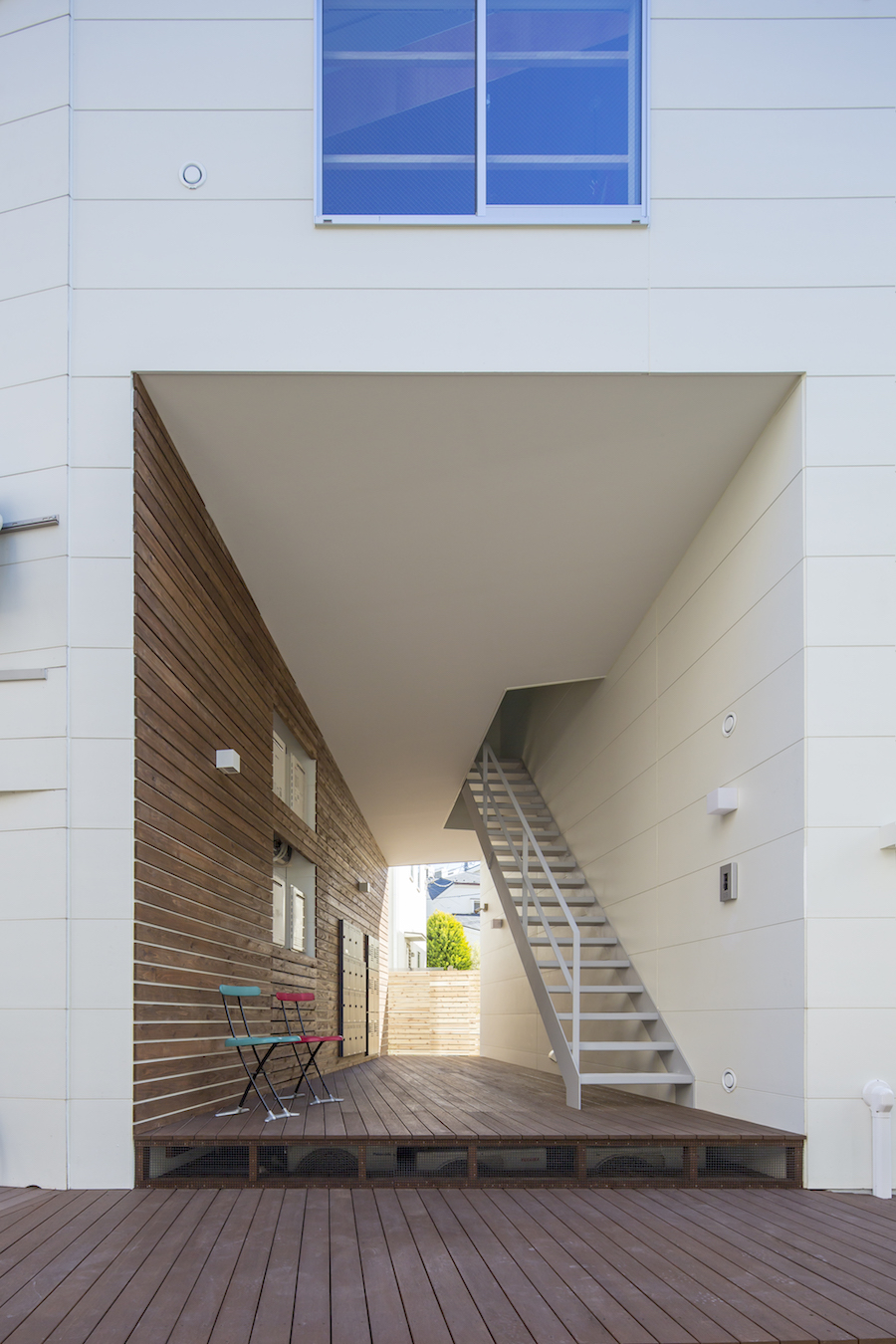敷地は広島県三原市中心部から車で30分ほどの山間にある。東側はこの地域を南北に抜ける道路に面し、南側に祖母と両親が暮らす母屋、西・北側には竹林を背負う。離れて暮らす夫婦が、ご主人の生まれ育ったこの土地に戻り、祖母・両親と一緒に暮らすための2世帯住宅の計画である。
施主からは「1世帯住宅の延長線上にある2世帯住宅」を求められた。2世帯住宅を設計する際には「世帯間の分け方」が課題となるが、家族の形態は10年、20年という時間単位の中で変化していく。その変化に対して包容力をもった器として機能する住宅を目指した。
外観は、自然に囲まれたこの土地で周囲に呼応しながらも堂々とした建ち方とするために、生活空間を収めた四角いボリュームの上に深い軒をもつ平らな大屋根を架けたシンプルなかたちとしている。
内部は1階に2世帯共有のLDK・水回りと親世帯の寝室を配置し、2階を子世帯のスペースとしている。
1階のLDKに全員が集まることが多いため、LDKを中心としながら吹き抜けや引戸の開閉により自分たちで全体に多様なつながりをつくることができる構成とした。
また、内外壁、天井高、吹抜け、軒下空間などのエレメントを通常の住宅スケールよりも大きく用い、世帯間あるいは部屋と部屋の間で「共有」させることにより、一見すると単純な構成ながらも、どの部屋が何の用途なのか、2世帯住宅なのかどうかさえもはっきりとしない「不透明」な状態をつくっている。
1つひとつのエレメントのスケールを大きくすることで大らかさの中に距離感や拡がりが生まれ、エレメントを共有することで全体につながりが生まれている。1つの屋根の下で暮らす家族としてのまとまりをもちながら、さまざまな変化に対してフレキシブルに対応できる住宅となった。(橋本雅尊)
A two-family house with larger elements and diverse connections
The site is located in the mountains, about 30 minutes by car from the center of Mihara City, Hiroshima Prefecture. The east side of the house faces a road that runs north-south through this area, with the main house where the grandmother and parents live on the south side and a bamboo grove on the west and north sides. This is a plan for a two-family house for a couple who live apart from each other to return to this land where the husband was born and raised and live with his grandmother and parents.
The client requested a “two-family house that is an extension of a one-family house,” and while “how to divide the household” is an issue when designing a two-family house, the family structure changes over the course of 10 or 20 years. We aimed to create a house that would function as a receptacle with the capacity to accommodate these changes.
The exterior of the house is simple, with a flat, large roof with deep eaves over a volume containing the living space, in order to create an imposing structure in harmony with its surroundings on this land surrounded by nature.
Inside, the LDK, water, and bedrooms of the parents are located on the first floor, and the second floor is the space for the children.
Since the family is close and often gathers in the LDK on the first floor, the LDK is the center of the house, but the atrium and sliding doors allow the family to create a variety of connections throughout the house by themselves.
The interior and exterior walls, ceiling height, vaulted ceilings, and space under the eaves are larger than the usual house scale and are “shared” between households or between rooms, creating an “opaque” state in which it is not even clear which room is for what purpose or whether the house is a two-family residence, despite its seemingly simple structure. The scale of each element is large.
By enlarging the scale of each element, a sense of distance and expansion is created within the grandeur of the house, and the sharing of elements creates a connection to the whole. While maintaining the cohesiveness of a family living under one roof, the house is flexible enough to respond to various changes. (Masataka Hashimoto)
【久井の長屋】
所在地:広島県三原市
用途:戸建住宅
クライアント:個人
竣工:2021年
設計:橋本雅尊建築設計事務所
担当:橋本雅尊
構造設計:倉内木造設計
施工:ホーム
撮影:藤井浩司(TOREAL)
工事種別:新築
構造:木造
規模:地上2階
敷地面積:677.52m²
建築面積:90.87m²
延床面積:148.22m²
設計期間:2019.08-2020.09
施工期間:2020.11-2021.10
【row house of kui】
Location: Mihara-shi, Hiroshima, Japan
Principal use: Residential
Client: Individual
Completion: 2021
Architects: Masataka Hashimoto ARCHITECTS
Design team: Masataka Hashimoto
Structure engineer: Kurauchi Structural Design
Contractor: HOME
Photographs: Koji Fujii / TOREAL
Construction type: New Building
Main structure: Wood
Building scale: 2 stories
Site area: 677.52m²
Building area: 90.87m²
Total floor area: 148.22m²
Design term: 2019.08-2020.09
Construction term: 2020.11-2021.10








